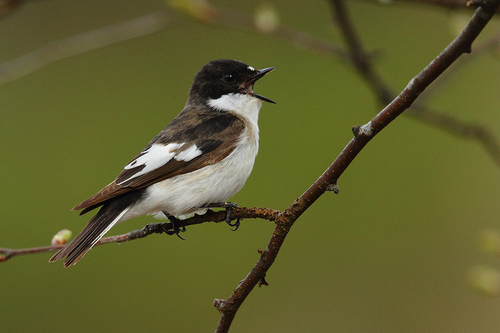
European Pied Flycatcher
The European Pied Flycatcher (Ficedula hypoleuca) is a small, striking passerine bird known for its distinctive black and white plumage in breeding males. It plays a vital role in controlling insect populations within its woodland habitats. This species is a popular subject of ecological study, particularly regarding its breeding behavior, migration patterns, and sensitivity to environmental changes. It holds no particular major cultural significance, but its arrival is often seen as a harbinger of spring in many parts of Europe.
12-13.5 cm
Length
21-24 cm
Wingspan
Least Concern
Conservation Status
Distribution
Breeds across most of Europe and western Asia. Winters in sub-Saharan Africa. Migrates along distinct routes, often crossing the Mediterranean Sea and Sahara Desert. The altitudinal range extends from sea level to mountainous regions, typically up to 2,000 meters.
Lifespan
Typically 2-3 years in the wild, but can reach up to 7 years.
European Pied Flycatcher's Habitat
Habitat Types
Deciduous woodlands, Mixed forests, Parks, Gardens, Orchards
Climate Zones
Temperate, Boreal
Adaptations
They are adapted to cavity nesting, readily utilizing natural tree holes or artificial nest boxes. Their migratory behavior is a key adaptation to exploit seasonally abundant food resources.
Variations
Several subspecies are recognized, including *F. h. hypoleuca*, *F. h. speculigera*, and *F. h. iberiae*, differing slightly in plumage and distribution. The Iberian Pied Flycatcher (*F. h. iberiae*) is sometimes considered a separate species.
Appearance
Breeding Plumage
Breeding males: Black upperparts, white underparts, large white wing patch, and white forehead spot. Non-breeding males and females: Brownish upperparts, paler underparts, and less prominent wing patch.
Seasonal Feather Changes
Males acquire their striking breeding plumage in spring through a pre-breeding molt. They revert to a duller plumage after breeding.
Sex Based Plumage Differences
Highly pronounced during breeding season. Females remain brown throughout the year.
Notable Features
Prominent white wing patch (especially in breeding males), White forehead spot (in breeding males), Short, fine bill adapted for catching insects
Diet and Feeding
Primary Foods
Flying insects, Caterpillars, Spiders, Beetles, Ants
Foraging Behavior
Typically hunts by 'flycatching' – making short flights from a perch to catch insects in mid-air. Also gleans insects from foliage.
Specializations
Agile flight and excellent eyesight are key adaptations for catching flying insects.
Seasonal Diet Variations
Diet shifts slightly depending on insect availability. May consume small berries and other fruits during migration and in winter.
Behavior
Social Structure
Generally solitary or in pairs during breeding season. Forms small flocks during migration and in wintering areas.
Communication
Variety of calls, including a sharp 'whit' call, A complex song used for territorial defense and mate attraction, Visual displays, such as wing-flicking and tail-bobbing
Migration
Long-distance migrant, traveling between Europe/western Asia and sub-Saharan Africa. Migrates at night, often in mixed-species flocks. Navigation likely involves a combination of magnetic orientation, star compass, and visual landmarks.
Territorial or Group Behaviors
Males are highly territorial during the breeding season, defending their nest site and surrounding area from rivals. They are less territorial outside the breeding season.
Conservation
Threats
Habitat loss (deforestation and woodland degradation), Climate change (affecting insect emergence and breeding timing), Pesticide use (reducing insect prey), Hunting during migration (in some regions)
Protection Programs
Protected under various international agreements, including the EU Birds Directive, Provision of nest boxes in areas with limited natural cavities, Habitat restoration and management
Local National Laws
Protected under national wildlife legislation in many European countries.
Population Trend
Stable
Population Estimates
Estimated global population of 23,000,000-39,999,999 mature individuals.
Interesting Facts
Males can be polygynous.
Some males will mate with and provide for multiple females, especially if nest sites are abundant.
They are known for their 'delayed dispersal'.
Young birds often return to breed near their birthplace, but may delay breeding for a year or more if competition for territories is high.
They are important model organisms in ecological research.
Their relatively short lifespan, ease of study in nest boxes, and sensitivity to environmental changes make them valuable for studying topics like climate change impacts and breeding ecology.
Faqs about European Pied Flycatcher
What do European Pied Flycatchers eat?
They primarily eat flying insects, caterpillars, and spiders. They catch their prey by 'flycatching' – making short flights from a perch to snatch insects in mid-air.
Where do European Pied Flycatchers migrate?
They breed in Europe and western Asia and migrate to sub-Saharan Africa for the winter.
Are European Pied Flycatchers endangered?
No, they are currently classified as 'Least Concern' by the IUCN, meaning they are not considered to be at high risk of extinction.
How can I attract European Pied Flycatchers to my garden?
Providing nest boxes in a suitable woodland or garden habitat can attract breeding pairs. Maintaining a healthy insect population by avoiding pesticide use is also beneficial.
Copyright @ Nature Style Limited. All Rights Reserved.
 English
English